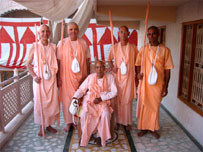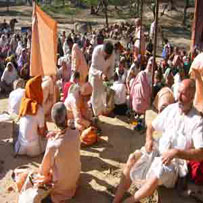A Brief Report of the Festival Awaited and desired by Parama-pujyapada Srila Narayana Maharaja for about sixty years, this year's Sri Navadvipa-dhama parikrama was held in Sri Vrndavana. As Vrndavana is hidden in Navadvipa, so Navadvipa is also hidden in Vrndavana. During this Navadvipa-Vrndavana parikrama, unforgettable moods were experienced and witnessed that would not have been possible in Navadvipa. On the second day, devotees completed parikrama of Govardhana's small side, which included Uddhava-kunda, Radha-kunda and Syama-kunda. Descending the staircase and kneeling down on the step just before the waters of Radha-kunda and Syama-kunda, Srila Maharaja performed puja of the two kundas. He offered incense, ghee lamp, flowers and milk. In the evening he glorified Sri Radha-kunda and explained that it is non-different from Rtudvipa in Navadvipa. He also related the pastimes of Sri Jayadeva Gosvami in Champahati, and explained how it is non-different from Kusuma Sarovara in Vrndavana. On the morning of March 3, the parikrama party circumambulated the large side of Govardhana with darsanas of Govinda-kunda, Apsara-kunda and Navala-kunda, and Surabhi-kunda. At Surabhi-kunda Srila Maharaja told some pastimes of that holy place and explained that Surabhi Kunda is non-different than Surabhi-kunja in Navadvipa. While still at Surabhi kunda, he then took the devotees by mind to Vidyanagara within Rtudvipa of Sri Navadvipa-dhama. There, he explained that Vidyanagara is the origin of all vidya (knowledge) including scriptures like the Vedas, Puranas, Upanisads, Srimad Bhagavatam, as well as other branches of knowledge like astrology and vyakarana (grammar). All rsis and munis and learned there and taught the entire world from there. Sankaracarya taught nirvisesa-vada (impersonalism) from there and the great scholar Sarvabhauma Bhattacarya took birth there. Srila Maharaja promised to tell, later that evening, about Modadrumadvipa and the pastimes of Lord Sri Ramacandra. He then he invited the several hundred devotees present to sit in lines and take a kichari and halava breakfast with him.
On March 4, the devotees took buses from Giriraja Gaudiya Matha to Ravel, Brahmanda Ghata and Gokula, and this parikrama place corresponded to the place of Sri Caitanya Mahaprabhu's birth and childhood pastimes in Mayapura in Navadvipa. Srila Maharaja also went with the devotees to these three holy places. At Ravel, after relating the story of Srimati Radhikas appearance there as a new-born baby playing on a beautiful large lotus flower, he explained why Ravel was their first stop. After all, Ravel is Srimati Radharani's place of birth, not Sri Krsna's. Krsnas birthplace is Gokula. Srila Maharaja said that just as we must get the mercy of Srimati Radhika in order to get the mercy of Sri Krsna, so we must get the mercy of Ravel to get the mercy of Gokula. The party then went to Brahmanda Ghata on the bank of the Yamuna, where Bhagavan Sri Krsna performed childhood pastimes. Srila Maharaja related the pastimes of young Nimai to the pastimes of young Krsna there, and then invited all the devotees to take breakfast with him. It was a traditional Bengali breakfast of flat rice mixed with water and sugar, and Srila Maharaja said that the prasadam had been personally prepared for the assembled devotees by Sacimata, the mother of Sri Sacinandana Gaura-hari. The parikrama party then went to Gokula, which is non-different from Antardvipa-Mayapura, Lord Caitanya's birthplace in Navadvipa. In the morning of March 5, continuing the observance of Gaura Mandala parikrama in Vrndavana under the guidance of Hari, Guru and Vaisnavas, the three hundred and fifty devotees from India and around the world visited Yavat, Nandagaon and Varsana. Then, on the way back to the Giridhari Gaudiya Matha where they were residing during the week long festival, they also took darsana (from afar) of Ter Kadamba, Uddhava-kyari, Sanket and Prema-sarovara. Srila Maharaja was personally with the international yatris (parikrama devotees) present in Yavat, the residence of Srimati Radhika's in-laws, and he sat with them all in the courtyard of Her Palace. There, watching the devotees as they perform kirtana, Srila Maharaja sat on a wooden table covered by beautiful cloths as he rested against a deep red velvet bolster. He was clad in saffron sannyasa robes, thick chaddar and turban as usual, and just behind him were the freshly painted saffron walls of the newly renovated courtyard. All the walls around the courtyard were fresh glossy saffron except for the temple archways, which were painted a golden-yellow with orange borders and deep pink sculptured lotus flowers. Srila Maharaja was very happy to see how the $5,000 donated by his Western disciples was successfully used in renovating and beautifying Srimati Radhika's temple and surrounding area. Before his lecture there, and before offering pranamas to the guru-parampara, Sri Caitanya Mahaprabhu and Srimati Radhika, Srila Maharaja had the devotees sing 'Dekhite Dekhite' by Srila Bhaktivinoda Thakura: ["When I will forget my gross bodily identity, then I will behold the exquisite beauty of Vraja, full of eternal spiritual bliss and cognizance. I shall take birth in Vrsabhanu Maharajas town and will marry in the nearby village of Yavat. My sole disposition and nature will be that of a cowherd maiden. When will I obtain, by the power of Radha's mercy, my own eternal spiritual body, my own realized name and dress embellishing my real form? And when will I receive initiation into the techniques of expressing divine love for Krsna? As I go to draw water from the Yamuna, I will understand the confidential mellows of Yugala-Kisoras loving affairs. Being captivated by prema, I will sing Srimati Radhika's glories just like a madwoman."] Before describing the pastimes of Srimati Radharani at Yavat, Srila Maharaja explained the etymological meaning of the word Yavat He said that "Yava" is the red foot-lac worn by chaste Indian ladies on the bottoms and sides of their feet, and "vata" means banyan tree. Krsna Himself, under the banyan tree in the courtyard of Srimati Radharani's palace, decorated Her lotus feet with this "java" or red foot-lac. With His own hands, He decorated Her lotus feet with His own names Krsna, Krsna, Krsna, Krsna as the design. After Srila Maharaja's lecture, which described in detail two of Srimati Radhika's unlimited pastimes with Sri Krsna there in Yavat, the leaders of Yavat village came forward to honor him by decorating him with lovely garlands and a golden silk chaddar with pink and silver fringes They also spoke words of glorification and appreciation of his being the pure representative of the Gaudiya-sampradaya lineage and having renovated their village's gradually dwindling and most important holy place of pastimes of the Divine Couple. The Yavat villagers and yatris then sang songs of Holi, and the lead singer played a drum with a three foot wide head. As the villagers sang and danced, they showered all the three hundred and fifty devotees in the audience with rose petals, and they also placed vermillion Holi powder on their foreheads to show their affection. They also threw upon everyone fine Holi powder. The Spring weather was beautiful a warm, sunny morning and reminded all of the Vasanta (Spring) rtu (season) Holi (splashing with colors) pastimes of Sri Sri Radha-Krsna along with the gopis and gopas. Every day of the parikrama, as the days grew closer to Gaura-Purnima, there was an increase of devotees arriving from India and abroad. By now, there were about four hundred and fifty in attendance. Later on, in the evening, Srila Maharaja arrived in the temple room of Sri Sri Giridhari Gaudiya Matha around 5:30 pm. As usual, the Bengali bhajanas and the prayers to Srila Prabhupada Bhaktivedanta Swami Maharaja and the guru-parampara were sung by all. After that, Srila Maharaja requested the ladies of Mathura and Delhi, headed by Srimati Madhu dasi and Sripada Damodara dasa to sing songs of Holi that is, Sri Krsna and the gopis squirting each other with syringes full of liquid colors, and throwing upon each other packets of powdered colors. Previous to Srila Maharaja's coming to the temple room, a few of the devotees had put five or six large baskets full of flower petals next to his vyasasana. So, during the Holi singing, Srila Maharaja and his assistants repeatedly showered the audience with these flower petals. The devotees present were reminded of the descriptions in the sastras depicting Bhagavan Sri Krsna's own lilas, in which demigods continuously showered flowers from the heavens. Srila Maharaja also threw a shower of fine Holi powder over the audience, and the devotees were reminded that he is a personal associate of Srimati Radhika. When the kirtanas were over, Srila Maharaja began his class, which was a glorification of the superiority of Sri Navadvipa-dhama over all other dhamas including Sri Jagannatha Puri. He gave abundant evidence to the fact that Navadvipa is non-different from Vrndavana, whereas Jagannatha Puri is compared to Dvaraka and not to Vrndavana. Like Vrndavana, Navadvipa-dhama is full with madhurya-bhava, the mood of sweet, human-like pastimes; whereas Jagannatha Puri, like Dvaraka, is full of aisvarya-bhava, the mood of opulence and awe and reverence. Srila Maharaja then called on several speakers to glorify the speciality of Sri Caitanya Mahaprabhu and His donation to the world, after which he made his audience weep by relating the pastimes of Sri Ramacandra. At the end of the class Srila Maharaja announced that on the next day Sri Gaura Purnima there would be initiations at 8:00 am. He then instructed all present how to observe that most holy day. After mangala-arati and morning bhajanas, senior devotees would take turns reading aloud about Sri Caitanya Mahaprabhu's pastimes from Srila Vrndavana dasa Thakura's Sri Caitanya-bhagavata until 4:00 pm. At 4 pm there would be a fire sacrifice for the newly initiates of harinama, diksa and sannyasa Bhajanas would begin at 5:00 pm, then Srila Maharaja's hari-katha, then abhiseka of Sri Caitanya Mahaprabhu in His Deity form, and then kirtana, arati and finally honoring maha-prasada. On the morning of Gaura Purnima, about 50 devotees received harinama or diksa initiations, and four brahmacaris received the sannyasa order of life. During the fire sacrifice in the late afternoon, Sripad Vana Maharaja brought the sannyasa cloths to Srila Maharaja to bless by touching, and at that time Srila Maharaja was speaking to disciples outside his room on the veranda of the Giridhari Gaudiya Matha. At the same time that he was solving the life-problems of those disciples by his instructions and glances imbued with krsna-prema, and at the same time he touched the clothes and in this way put his spiritual power in it. He then went into the temple room to give the sannyasis their dandas, cloths and sannyasa mantras. Jnana dasa became Pujyapad BV Gabhastinemi Maharaja, Janardana dasa became Pujyapad BV Vaikhanasa Maharaja, Krsna-prasada dasa became Pujyapada BV Muni Maharaja and Rama-Vijaya dasa became Pujyapada BV Srauti Maharaja. All these names are names of Srila Prabhupada Bhaktisiddhanta Sarasvati Thakura's sannyasa disciples. At the beginning of his evening class, Srila Narayana Maharaja called upon these four new sannyasis to speak, to the now five hundred and fifty devotees present, on the subject of the teachings of Lord Caitanya. He encouraged them and corrected them in their presentations, and in this way he began their rigorous training in their new asrama. The next morning, March 7th, was the anniversary of the day that Sri Jagannatha Misra held the feast for the birthday of his new son, Nimai. Srila Maharaja held more initiations that morning, and in the evening he read from Sri Caitanya Bhagavata about the festival of Jagannatha Misra. He also kindly translated the verses into English. He then completed the Gaura Purnima festival by giving a brilliant lecture of the essence of Sri Caitanya Mahaprabhu's teachings -- Sri Siksastakam. Editorial Advisors: Pujyapada Madhava Maharaja and Sripad Brajanatha dasa
|
Navadvipa-Vrndavana-dhama Parikrama
- Details







